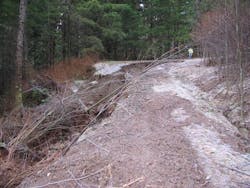Holding Back the Landslide
In January 2009, Whatcom County in the state of Washington had a rainstorm. It was not just any rainstorm, though—it happened when there was already snow on the ground. The storm hit an area near the Middle Fork Nooksack Diversion Dam particularly hard, causing significant erosion, washout and landslide damage.
Access denied
On several stretches of nearby roadway, the erosion cut from 2 to 10 ft deep. Originally, the site had two culverts passing under the roadway, but “the culverts had become plugged during the storm event,” said Aaron Hartvigsen, P.E., of GeoEngineers Inc. “The debris load overtopped the road and culvert and completely filled in the diversion structure located below.”
The slide made the road completely impassable. This was a major problem because the road provides the only access to the diversion dam, which is critical to maintaining a clean water source for the City of Bellingham, especially during dry summer months.
Bridging the gap
For a long-term solution, the city turned to GeoEngineers, Inc. The area is subject to high dynamic forces as a result of the debris flows that occur during major climatic events, so the engineers’ goal was to design a solution that would reestablish access and reduce the risk of future washouts and overtopping of the access road. Redirecting future water and debris flow away from the diversion dam facilities was one of the project’s major priorities.
To accomplish these goals, GeoEngineers created a plan to realign the drainage channel and add a bridge that was to be made using two flatbed railroad cars. The bridge required abutments and wing walls, for which GeoEngineers recommended Redi-Rock walls, “because they are unique in that they are large blocks that have a positive connection between the geogrid and the block itself,” according to the engineering report GeoEngineers presented to the city. “The big blocks and positive connection provides the greatest resistance under these circumstances for the lowest cost.”
The railroad cars sit directly on the Redi-Rock abutments, and the Redi-Rock wing walls help prevent erosion around the bridge structure. These walls utilize the Redi-Rock reinforced solution, which relies on a strong connection between the geogrid and the block itself. The upper walls were reinforced with Miragrid 5XT.
On the lower walls, “we arrived at a gravity system because of the shorter height requirement,” said Hartvigsen. “Using gravity walls allowed us to reduce excavation on that portion of the project, because we didn’t have to cut the slope back as far.”
Redi-Rock gravity walls harness the power of gravity by using 2400-lb. blocks that weigh as much as a Clydesdale horse. The massive size of each block allows for reduced excavation and faster installation. The ability to utilize both gravity and reinforced walls on the same project—thanks to a uniform look—is a major benefit of the Redi-Rock system.
In total, the project required 165 linear ft of Redi-Rock walls that stand up to 15 ft high (including embedment) and taper down to 4 ft high; this totaled 1,750 sq ft of wall facing. After permitting and funding were finally secured—more than two years after the event—the construction portion of this project was completed within two months.


